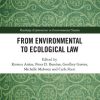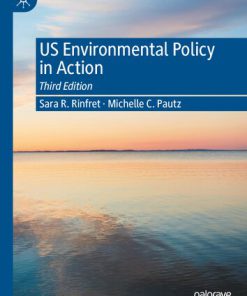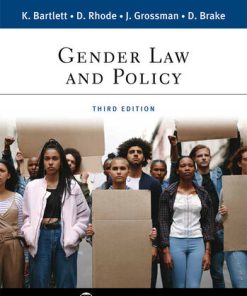An Introduction to Environmental Law and Policy in Canada 3rd Edition by Julie Williams, Paul Robert Muldoon ISBN 9781772555721 177255572X
$50.00 Original price was: $50.00.$25.00Current price is: $25.00.
An Introduction to Environmental Law and Policy in Canada 3rd Edition by Julie Williams, Paul Robert Muldoon – Ebook PDF Instant Download/Delivery: 9781772555721 ,177255572X
Full download An Introduction to Environmental Law and Policy in Canada 3rd Edition after payment
Product details:
ISBN 10: 177255572X
ISBN 13: 9781772555721
Author: Julie Williams, Paul Robert Muldoon
An Introduction to Environmental Law and Policy in Canada 3rd Edition Table of contents:
Part I: Introduction: The Evolution and Framework of Environmental Law
Chapter 1: Environmental Law and Its Evolution in Canada
I. Introduction: What Is Environmental Law?
II. The Scope of Environmental Law
III. Ideas Underlying Modern Environmental Law
Public Welfare and Citizen Participation
Philosophy and Ethics
IV. The Role and Place of Environmental Law
Laws of General Application and Sectoral Laws
V. Four Evolutionary Phases in Canadian Environmental Law
Phase 1: Common Law Rights and Early Statutes
Phase 2: Waste Control and Cleanup Laws
Phase 3: Toxics Control Laws
Phase 4: Comprehensive Approaches to Environmental Assessment and Planning and Management Regimes
VI. Four Associated Trends in Environmental Law
Regional, Continental, and Global Effects
Transparency and Citizen Participation
International Influences
Effective and Efficient Application of the Law
VII. Three Big Challenges for Environmental Law
Sustainability
Complexity and Uncertainty
Protection and Transformation
Summary of Key Points
Key Terms
Discussion Questions
Suggested Readings
Chapter 2: The Canadian Legal Framework
I. Introduction: Law in Our Society
II. Legal Systems
III. The Role of the Constitution
IV. The Constitutional Division of Powers
V. Municipal Jurisdiction
VI. Indigenous Law and Aboriginal Jurisdiction
VII. Statutes and Subordinate Legislation
VIII. How Laws Are Made
Statutes
Regulations
IX. The Concept of Jurisdiction
X. Discretionary Decisions and Policies
XI. The Concept of Liability
XII. Courts and Tribunals
How Courts Work
How Tribunals Work
XIII. Dispute Resolution
Summary of Key Points
Key Terms
Discussion Questions
Suggested Readings
Notes
Part II
Aspects of Environmental Law
Chapter 3
Part II: Aspects of Environmental Law
Chapter 3: Environmental Law and Indigenous Peoples
I. Introduction
II. Key Constitutional, Statutory, and Treaty Documents
III. Common Law
Calder v British Columbia (1973)
R v Sparrow (1990)
Delgamuukw v British Columbia (1997)
Taku River Tlingit First Nation v British Columbia (Project Assessment Director) (2004)
Haida Nation v British Columbia (Minister of Forests) (2004)
Tsilhqot’in Nation v British Columbia (2014)
Mikisew Cree First Nation v Canada (2018)
IV. Treaties
Consultation Requirements Under Treaties
Guidance on Consultation Obligations
V. International Law and Indigenous Peoples
VI. Conclusion
Summary of Key Points
Key Terms
Discussion Questions
Suggested Readings
Notes
Chapter 4
Chapter 4: The Relationship Between Canadian and International Law
I. Introduction: Understanding the Nature of International Law
Conventional International Law
Customary International Law
II. Who Are the Players in International Law?
The Role of the United Nations
III. The Relevance of International Law to Canadian Environmental Law
IV. The Future of International Environmental Law
Summary of Key Points
Key Terms
Discussion Questions
Suggested Readings
Notes
Part III
Regulatory Regimes
Chapter 5
Part III: Regulatory Regimes
Chapter 5: Environmental Protection Regimes and Regulatory Tools
I. Introduction
II. Private Law
Common Law Rights
III. Public Law
IV. Basic Types of Environmental Regulatory Regimes
Media-Based Regimes
Approval-Based Regimes
Sector-Based Regimes
The Overlapping Nature of Environmental Regimes
More Integrated Environmental Assessment and Planning Approaches
V. The Command and Control Model — A Deeper Dive
The Command Tool Box: Setting Standards for Environmental Behaviour
Approaches to Standard Setting
The Control Toolbox: Compliance and Enforcement
Summary of Key Points
Key Terms
Discussion Questions
Suggested Readings
Notes
Chapter 6
Chapter 6: Sectoral Regulatory Regimes
I. Introduction
II. Fossil Fuels
Oil and Gas
Oil Sands
Coal
Federal Regulation
III. Nuclear Energy
International Law
Federal Regulation
IV. Mining and Aggregates
Mining
Aggregates
V. Fisheries
VI. Forestry
VII. Agriculture and Aquaculture
Agriculture
Aquaculture
VIII. Pesticides
International Regulation
Federal Regulation
Provincial Regulation
Municipal Regulation
IX. Biotechnology and Genetic Engineering
Applications of Genetic Engineering
Risks
The Legal Framework
Summary of Key Points
Key Terms
Discussion Questions
Suggested Readings
Notes
Part IV
Integrated Approaches to Environmental Law
Chapter 7
Part IV: Integrated Approaches to Environmental Law
Chapter 7: Environmental Assessment
I. Introduction
II. The Origins and Evolution of Environmental Assessment Law
The US National Environmental Policy Act of 1969
The Establishment of Environmental Assessment Law in Canada
III. Basic and Advanced Components of Environmental Assessment Laws
IV. Canadian Federal Assessment Law
The Canadian Environmental Assessment Acts of 1995 and 2012
The 2019 Impact Assessment Act
V. The Ontario Environmental Assessment Act and Process
VI. Other Particularly Notable Assessment Provisions and Practices in Canada
VII. The Future of Environmental Assessment
Upward Harmonization
Cumulative Effects and Strategic-Level Assessments
Sustainability-Based Assessment
Summary of Key Points
Key Terms
Discussion Questions
Suggested Readings
Notes
Chapter 8
Chapter 8: Planning and Management Regimes
I. Introduction
II. Crown Land Management
Crown Land
Sectoral Resource Development Law
Public Land Planning and Management
III. Parks and Other Protected Areas
International Law
Federal Parks
Provincial Parks
Partnerships with Indigenous Peoples
Private Landowners
Marine Areas
Remaining Challenges
IV. Endangered Species
Species at Risk
International Trade
Habitat Loss
Climate Change
V. Urban Planning, Growth Management, and Brownfields
Land Use Planning
Roles and Responsibilities
Land Use Planning as a Growth Management Tool
Brownfields Redevelopment
VI. Watershed Planning and Source Water Protection
Watershed Planning in Ontario
The Walkerton Tragedy
Ontario’s Clean Water Act
Remaining Challenges
Future Challenges
VII. Electric Power Systems
Conservation and Demand Management
Renewable Energy Sources
Energy System Transition
Summary of Key Points
Key Terms
Discussion Questions
Suggested Readings
Notes
Chapter 9
Chapter 9: Corporations and Harnessing Market Forces
I. Introduction
II. Corporate Law
Liability and the Corporate Veil
Corporate Mandate
III. Economic Instruments
Types
Behavioural Economics
IV. Non-Regulatory Instruments
Types
Voluntariness
Advantages and Disadvantages
V. Drivers of Change
Summary of Key Points
Key Terms
Discussion Questions
Suggested Readings
Notes
Part V
Protecting Environmental Rights
Chapter 10
Part V: Protecting Environmental Rights
Chapter 10: Using the Courts to Protect the Environment
I. Introduction
II. Environmental Issues and Private Actions
III. The Challenges of Environmental Litigation
IV. Standing
The Traditional Standing Rule
Public Interest Standing
V. Class Actions
VI. Interventions
Added Party
Friend of the Court
Public Interest
VII. Causes of Action
Nuisance
Trespass
Negligence
Strict Liability
Statutory Causes of Action
VIII. Causation: Establishing the Cause–Effect Relationship
IX. Damages and Remedies
Monetary Damages
Equitable Relief
X. Costs
XI. Mediation
XII. Court Action as an Environmental Protection Tool: Its Limits and Potential
Causal Links and Quantifying Damages
Summary of Key Points
Key Terms
Discussion Questions
Suggested Readings
Notes
Chapter 11
Chapter 11: Using Administrative Decision-Making Processes to Protect the Environment
I. Introduction
II. Types of Administrative Decision-Making
III. Tribunal Procedures
Natural Justice and Procedural Fairness
Evidence
Record
Parties
Decisions and Reasons
Costs
IV. Appeals
Environmental Appeal Boards
V. Substantive Judicial Review
Standing
Reviewing the Merits of a Decision: The Standard of Review and Grounds for Judicial Review
VI. Public Inquiries
Summary of Key Points
Key Terms
Discussion Questions
Suggested Readings
Notes
Chapter 12
Chapter 12: Environmental Bill of Rights and Access to Information
I. Introduction
II. Canada’s History of Environmental Rights
Environmental Law and the Right to Participation
The Origin of Environmental Bills of Rights in Canada
Ontario’s Approach to Protecting Environmental Rights
Public Participation Rights
Court Access
Whistle-Blower Protection
Accountability
III. Access to Information
Access to Information Statutes
Summary of Key Points
Key Terms
Discussion Questions
Suggested Readings
Notes
Part VI
Emerging Issues
Chapter 13
Part VI: Emerging Issues
Chapter 13: Emerging Issues
Introduction
I. Using the Law to Mitigate Climate Change
Discussion Questions
NOTES
II. Human Health Effects of Climate Change
Discussion Questions
NOTES
III. Water Fluoridation and Evidence-Based Policy-Making
Discussion Questions
NOTES
IV. Banning Single-Use Plastics
Discussion Questions
NOTES
V. Alberta Oil and Gas Well Cleanup
Discussion Questions
NOTES
VI. Environmental Implications of Energy Trade and Investment—NAFTA and USMCA
Discussion Questions
NOTES
VII. The Emergence of Electric Cars
Discussion Questions
NOTES
VIII. Animal Rights Law
Discussion Questions
SUGGESTED READINGS
NOTES
IX. High-Stakes Law: Going to Court for Species at Risk
Discussion Questions
NOTES
X. Civil Disobedience
Discussion Questions
NOTES
Glossary
Index
People also search for An Introduction to Environmental Law and Policy in Canada 3rd Edition:
an introduction to environmental law and policy in canada pdf
introduction of environmental law
an introduction to environmental science
an introduction to environmental science answer key
an environmental law
Tags: Julie Williams, Paul Robert Muldoon, Environmental Law, Policy, Canada
You may also like…
Uncategorized
Jurisprudence & Law
Environmental Protection Law and Policy 8th Edition Robert L. Glicksman
Politics & Philosophy - Government & Politics
Jurisprudence & Law - Environmental Law
US Environmental Policy in Action 3rd Edition Sara R. Rinfret
Uncategorized
Jurisprudence & Law
Uncategorized
Commercial & Financial Law












